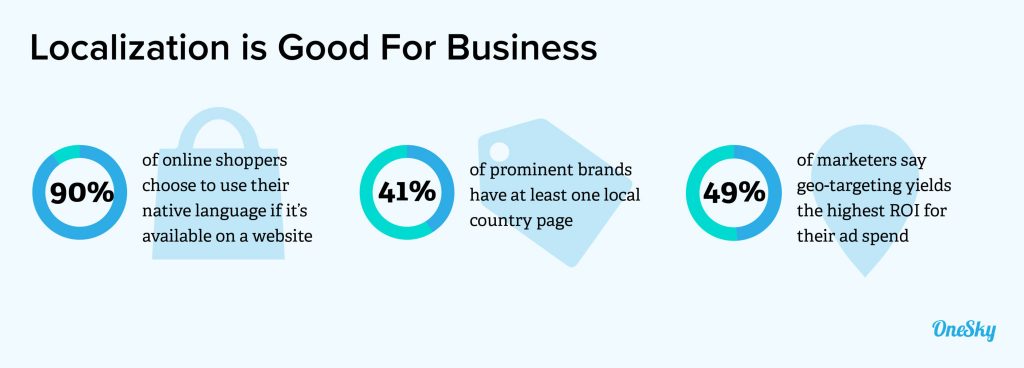In today’s interconnected world, your web application should be designed to cater to a diverse user base right here in the USA. Whether you’re developing a brand-new app or looking to expand your existing one, it’s essential to have a strategy that ensures a top-notch user experience for all potential users across the nation.
Apps are all about being user-friendly and accessible to everyone, regardless of their location or language preference. Gone are the days of simply ‘translating’ your app into a generic version that might not fully resonate with your American users. Instead, the key is to craft localized versions of your app that feel as though they were made especially for native speakers right here in the USA, considering everything from regional language variations to cultural references and even measurement units.
If your goal is to reach a wide and diverse audience within the United States, you’ll discover how to ensure your web app seamlessly adapts to various regions, languages, and cultural nuances. We’ll discuss testing methods and provide valuable tools and techniques to simplify and enhance the entire localization process, so your app can shine in the eyes of American users from coast to coast.
Maximizing Localization Impact with Data Analysis

Source: OneSky
- The global language services industry is forecasted to grow by $5 billion, reaching $56 billion in 2021. It is expected to achieve a compound annual growth rate (CAGR) of 5.3% from 2021 to 2026.
- A study by Common Sense Advisory found that 75% of US consumers are more likely to buy from a website that is in their native language.
- A study by CSA Research found that 56% of US consumers said they would be more likely to recommend a company that offers its website in their native language.
- A study by Nimdzi found that localized websites can increase conversion rates by up to 17.8%.
- A study by HubSpot found that businesses with localized websites see a 24% increase in search engine traffic.
Differences: Globalization, Internationalization, Localization, and Translation
- Globalization is the process of making your web app ready to perform on the world stage, including the United States. It involves designing the core structure and functionalities so they can adapt to different regions and languages. This means creating a solid foundation that allows for internationalization and localization down the road.
- Internationalization, often abbreviated as “i18n” (because there are 18 letters between ‘i’ and ‘n’ in “internationalization”), is all about making your app flexible enough to be understandable and functional in various regions, languages, and cultures. This might involve things like using placeholders for text that will be replaced with actual content during localization or ensuring the app can handle different date and time formats or numerical systems. In essence, internationalization makes your app “world-ready.”
- Localization is the process of customizing your app to specific regions, like tailoring costumes, dialogue, and props for different acts. Localization involves adapting content, language, and even design to resonate with local preferences and culture. For the U.S, this means ensuring your app feels like it was crafted especially for users in this country, acknowledging their unique language variations, cultural references, and measurement standards.
- Translation is the act of converting text and content from one language to another while preserving its meaning and context. This might involve translating your app’s text from English to Spanish to reach a broader audience within the U.S. Translation is a crucial component of localization.
Distinguishing Between Globalization, Internationalization, Localization, and Translation
| Concept | Definition | Example |
| Globalization | Prepares a web app for a global audience by building a versatile foundation. This includes accommodating multiple languages, regions, and cultures. | Building a web app framework that can seamlessly switch between English, Spanish, and French to cater to a diverse user base worldwide. |
| Internationalization | Designs an app to be region-agnostic. This involves strategies like isolating text from code, supporting various date and time formats, and ensuring numerical data presentation is adaptable. | Avoiding hard-coded text, using resource files to store translatable text, and designing the app in a modular way so that it is easy to localize. |
| Localization | Customizes an app for specific locales or cultures, considering language, currency, units of measurement, and cultural references. | Translating the user interface, content, and help documentation into the target language, as well as adapting the design and functionality to suit the cultural norms and expectations of the target market. |
| Translation | Converts text and content from one language to another while preserving original meaning and context. | Translating all user interface elements, labels, and content from English to Spanish, ensuring a seamless experience for Spanish-speaking users in the U.S., including product descriptions and customer support resources. |
How to conduct Website Localization?
Website localization is a critical process for reaching a global audience effectively. Here are the essential steps to ensure successful website localization:
Prepare Your Codebase for Internationalization (i18n):
Begin by structuring your codebase to be language-agnostic. Use libraries and frameworks that support i18n. This involves separating content, like text and images, from code.
Choose a Localization Framework:
Select a localization framework or library that suits your technology stack. For example, if you’re using JavaScript, consider tools like i18next or react-i18next.
Extract Translatable Content:
Identify all translatable content in your web app. This includes user interface labels, button text, tooltips, and error messages. Extract these strings and place them in separate resource files.
Create Locale Files:
Develop locale files for each language you plan to support. These files should contain translated versions of the extracted content. Use a standardized format like JSON for easier integration.
Implement Language Switching:
Build a user-friendly language-switching mechanism in your app’s settings or navigation. Ensure that the selected language persists across sessions.
Design for Text Expansion:
Account for text expansion when translating into languages that may have longer words or phrases than the source language. Adjust the layout and design to prevent text overflow issues.
Use Localization Testing Tools:
Employ localization testing tools like LingoHub or Lokalise to streamline the testing process. These tools can help you manage translation resources and identify potential issues.
Monitor Localization Metrics:
Implement tracking mechanisms to monitor localization metrics, such as user engagement, language preferences, and conversion rates for different languages. Tools like Google Analytics can be instrumental.
Provide Context for Translators:
Collaborate closely with translators, providing them with context and access to the web app for a better understanding of where and how their translations will be used.Handle Plurals and Date/Time Formats:
Develop logic to handle pluralization and date/time formats dynamically based on the selected language. Libraries like moment.js can assist with this.
Localization in Action: Popular US Web Apps
- Duolingo is a popular language learning app that offers courses in over 100 languages. The company has localized its app and marketing materials for each of the markets it serves, which has helped it to achieve global success.
- For example, Duolingo has created localized versions of its app for Spanish speakers in Mexico and Spain. The Mexican version of the app uses Mexican Spanish vocabulary and cultural references, while the Spanish version uses Spanish from Spain. This localization strategy has helped Duolingo to attract and retain users in both markets.
- Netflix is another company that has benefited from localization. Netflix offers streaming services in over 190 countries and territories, and it has localized its content and user interface for each market.
- For example, Netflix offers subtitles and dubbing in multiple languages, and it recommends content to users based on their location and viewing history. Netflix also creates original content in different languages, such as the Spanish series “Casa de Papel” and the German series “Dark.” This localization strategy has helped Netflix to become the world’s leading streaming service.
- McDonald’s is a global fast food chain that has over 38,000 restaurants in over 100 countries. McDonald’s has localized its menus and marketing materials for each of the markets it serves.
- For example, McDonald’s offers a different menu in India than it does in the United States. The Indian menu includes items such as the McAloo Tikki burger and the McSpicy chicken sandwich. McDonald’s also markets its restaurants differently in different countries. For example, in India, McDonald’s emphasizes its family-friendly atmosphere and its commitment to quality ingredients.
- Starbucks is a global coffeehouse chain that has over 33,000 stores in over 80 countries. Starbucks has localized its stores and menus for each of the markets it serves.
- For example, Starbucks stores in China are designed to be more spacious and comfortable than Starbucks stores in the United States. Starbucks also offers a different menu in China, which includes items such as the green tea latte and the mooncake frappuccino. This localization strategy has helped Starbucks to become the leading coffeehouse chain in China.
- Amazon is a global e-commerce company that sells products to customers in over 200 countries. Amazon has localized its website and product selection for each of the markets it serves.
- For example, Amazon offers a different selection of products to customers in India than it does to customers in the United States. Amazon also offers its website in multiple languages, and it provides localized customer support. This localization strategy has helped Amazon to become the world’s leading e-commerce company.
Last Thoughts
Localization is a crucial strategy for businesses that want to succeed in the US market. By adapting their products, services, and marketing materials to the local culture and language, businesses can connect with their target audience on a deeper level and build trust.
GeekyAnts is a leading localization company that can help businesses of all sizes to localize their content and products for the US market. With a team of experienced and qualified linguists and localization experts, GeekyAnts can help businesses to translate their content into accurate and idiomatic US English,Adapt their marketing materials to the US culture,Localize their products and services to meet the needs of US customers
If you are a business that wants to succeed in the US market, consider working with a localization company like GeekyAnts to help you adapt your products, services, and marketing materials to the local culture and language.
Connect with Us – We Love Hearing from You!


















